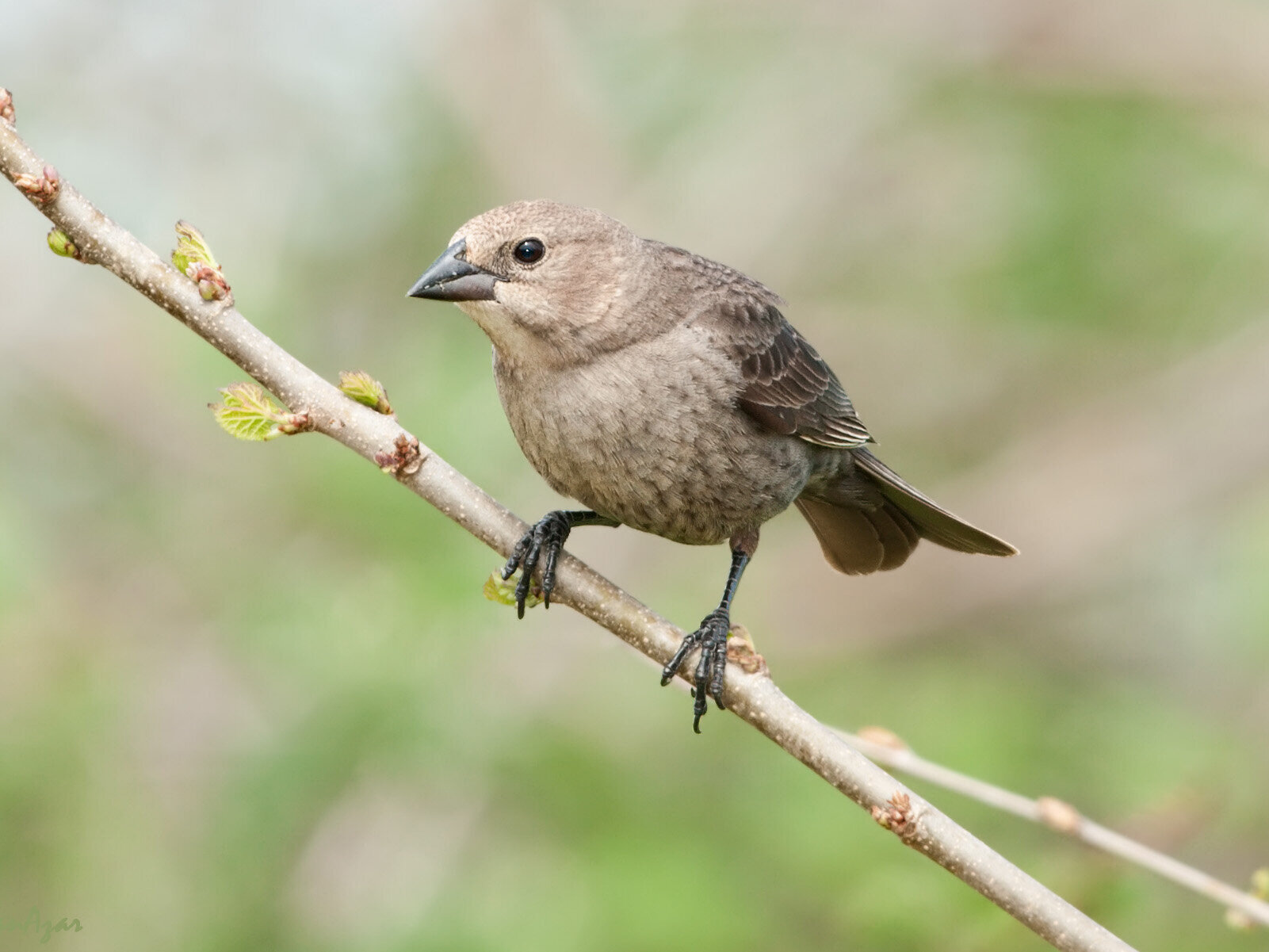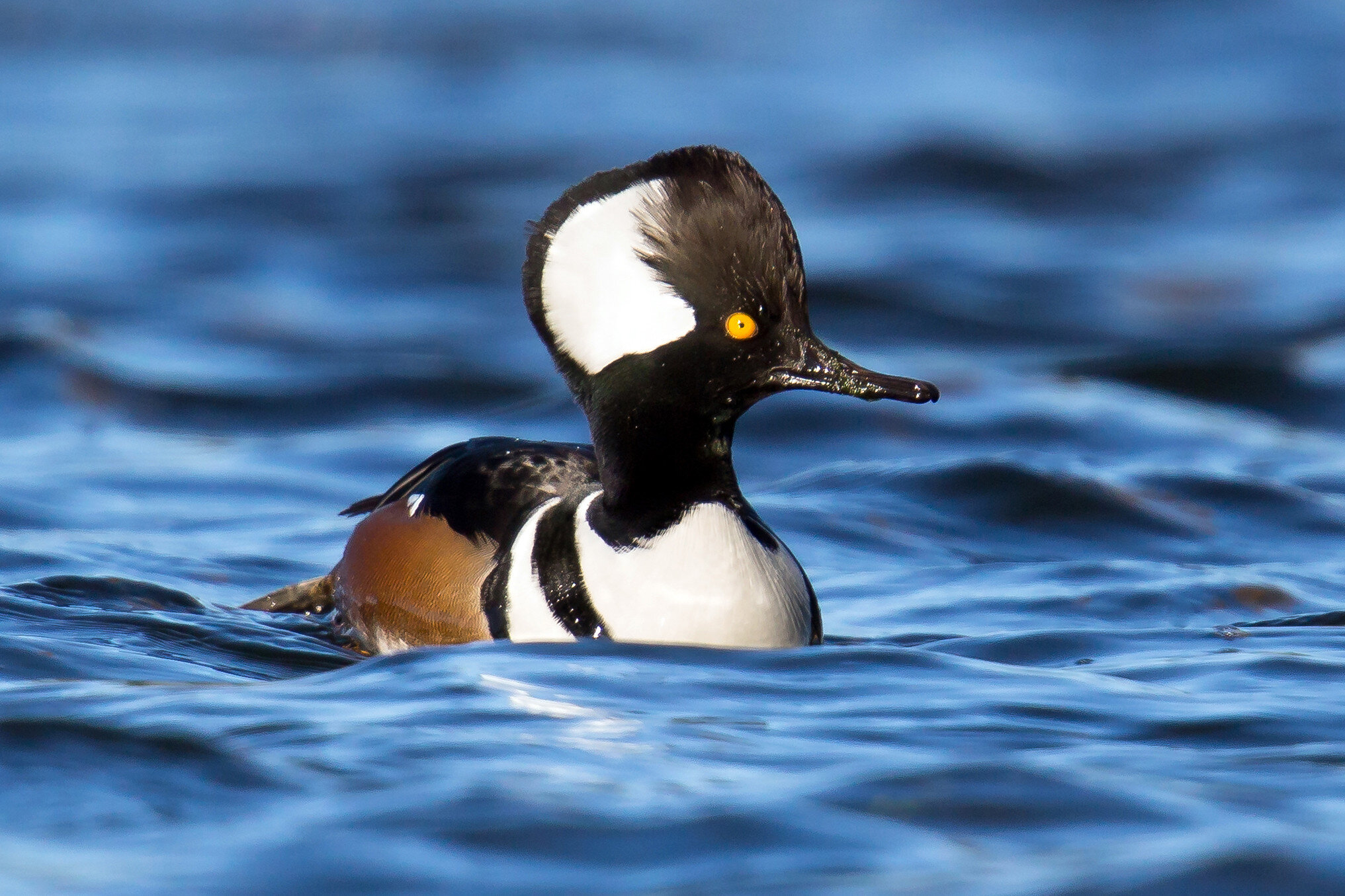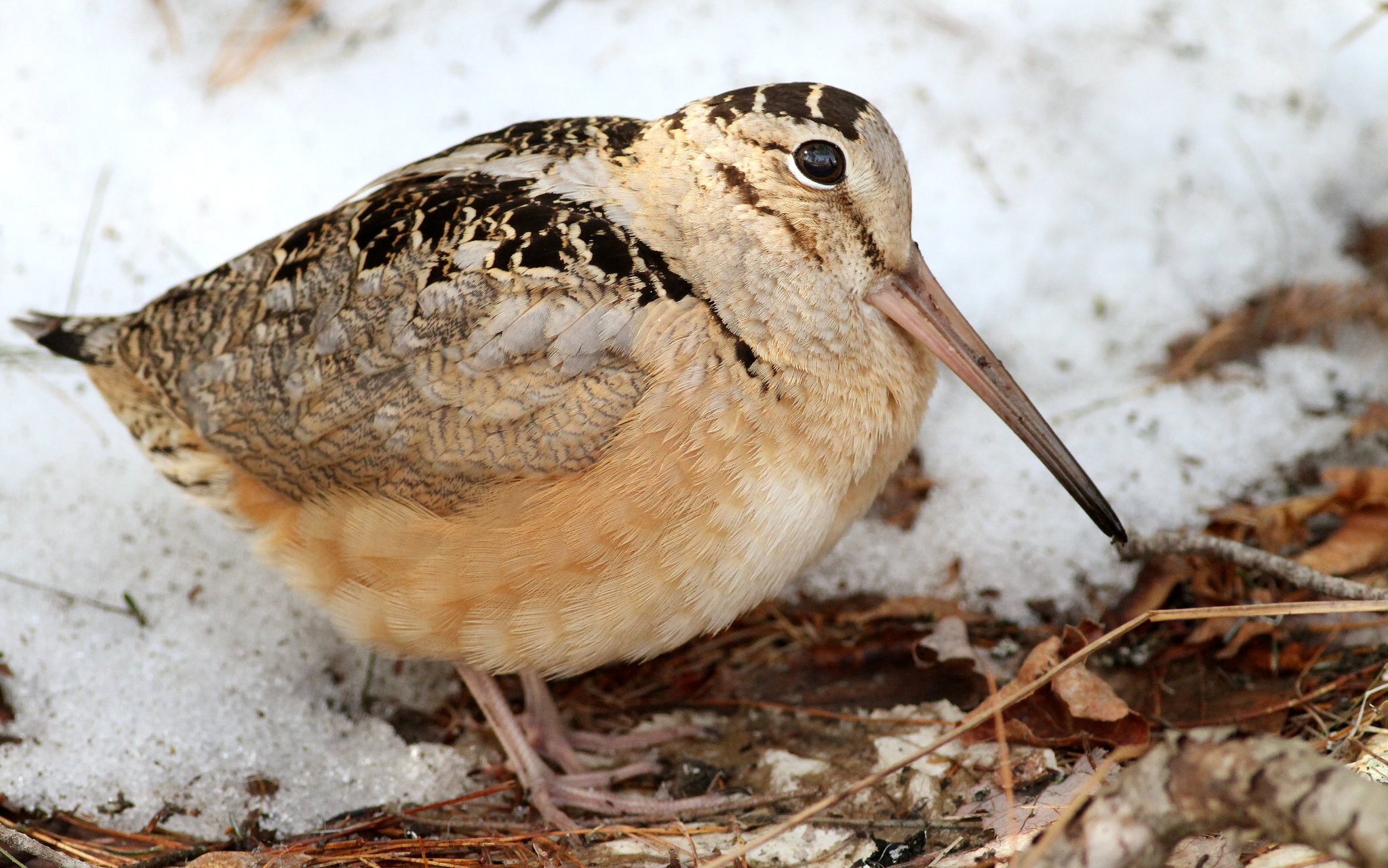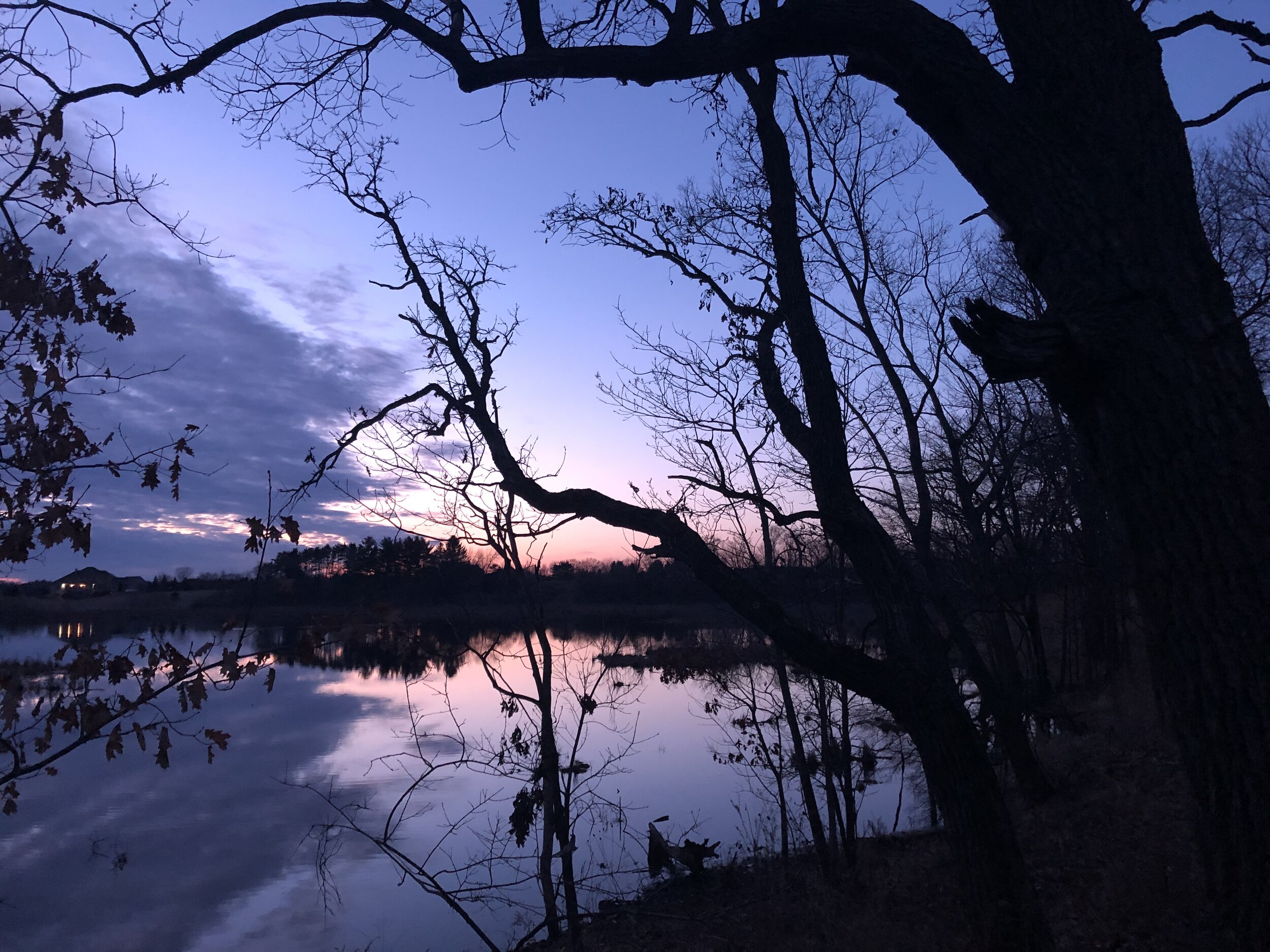Calla is checking out the sights, photo by Graham Steinhauer
We decided to hold an “Earth Day” Goose Pond Sanctuary Bird Count to reflect on changes to the sanctuary over the past 50 years. On April 23, 2020, Graham Steinhauer and Calla Norris counted in one team while Mark counted by himself in order to maintain social distancing.
On a gray day like April 23, it’s difficult to guess what birds you will find. You see a few drab shapes (save for the striking black and white contrast of diving ducks) swimming in the shallows or flitting about in the bushes. It takes a decent pair of binoculars, patience, and some help from a field guide to figure out what is actually going on.
We were very pleased to find 53 bird species and 2,668 individuals. The water levels have remained high since March of 2019, and helped contribute to the high number of water birds. The three and one half hour count was conducted with clouds, 10 mile per hour winds and a high of 52 degrees. The 2020 spring migration for some species is late. Usually all geese have headed north except for one or two nesting pairs, and we were surprised to find 529 Canada geese, 70 cackling geese, 4 snow geese and 2 greater white-fronted geese. The main reason we conducted the count was to document early nesting species including Canada geese and ducks.
The highlight of the day regards wood ducks. There are two duck boxes at Goose Pond, and one of them has been inhabited by hooded mergansers for the last six years. Where are the wood ducks? We probably have low densities of wood ducks because there isn’t a lot of woody cover. This year Graham erected a third duck box two weeks ago. He checked it yesterday (April 23) and voilà! A hen wood duck popped out of the box, and she was sitting on a clutch of eggs. This is the first record of wood ducks nesting at Goose Pond.
Wood duck couple, photo by Monica Hall
Other observations of note include finding three goose nests in the Manthe wetlands on muskrat houses, 14 species of ducks including a pair of pintails and a lone male, a record of 175 mallards (129 pairs - 46 pairs seen and 83 lone drakes where the females are nesting), 43 double-crested cormorants, an estimated 464 tree swallows that were mostly hunting over the water due to cool weather and a record number of 53 yellow-rumped warblers that were also busy catching insects. Mark will long remember watching duck butts on the Manthe wetlands from Kampen Road. There were blue-winged teal, northern shovelers, gadwalls, mallards, and northern pintails feasting in the shallow water.
At feeders during this time of year we trade juncos for goldfinches, chickadees for white-crowned sparrows, and tree sparrows for blackbirds… red-winged and yellow-headed, as it turns out! For a period of five days, three yellow-headed blackbird males frequented bird feeders at the Prairie Lane Residence. We didn’t see any yellow-headed blackbirds during our count, but we’re delighted to have seen them within the last week.
Yellow-headed blackbirds looking at Graham, looking at them. Photo by Graham Steinhauer
Beyond the checklist itself, surveying all of the water and some of the uplands on Goose Pond’s 660 acres, gives you insight on the importance of each habitat or even microhabitat. We try to provide as many quality pieces of habitat for grassland, savanna, and wetland birds as we can. Here are a few examples of the specificities required by bird species.
A beautiful yellow-rumped warbler, by Richard Armstrong
Green-winged teal were found almost exclusively in the wetland scrapes south of the Kampen Road Residence.
Almost all of the yellow-rumped warblers were seen flying back and forth from a patch of sumac to large oak trees.
85% of ring-neck ducks were found in a thin isthmus of vegetation and flooded cottonwood stumps. We cut those cottonwoods in the winter of 2018.
464 tree swallows were seen during this count, and they were either on their nest box, in the air, or on one particular small dead tree. There was seemingly nothing special about this tree besides that it was near the water where they were feeding. At least 120 tree swallows were seen occupying its few thin branches at a time.
One downy woodpecker was observed, and it was on the best (ask a downy what that means) of three snags at Goose Pond.
Fifty years ago Madison Audubon had just acquired 60 acres along Prairie Lane, and restoration efforts did not begin until 1976 with the planting of the Bicentennial Prairie. In 1970 there was very little nesting cover in the local area and no restored wetlands.
Today, Madison Audubon owns 660 acres that includes over 400 acres of restored prairie. With the high water and our 20 acre acres of restored wetlands there are 180 acres covered by water in the local area. Our neighbors Rollie and Lynn Manthe have their land in wetland and restored prairie habitat. Judi Benade, a neighbor to the west, has another 75 acres of wildlife habitat. The upland nesting ducks and grassland bird numbers have greatly responded to the increase in grassland cover.
Fifty years ago, there were no Canada geese, wood ducks, hooded mergansers, sandhill cranes, northern harriers, or clay-colored sparrows nesting in the area.
Sandhill cranes happily nest at Goose Pond Sanctuary in 2020. Photo by Arlene Koziol
In 1985 Mark and Sue began erecting kestrel nesting boxes and have greatly expanded the kestrel nest box project thanks to coordination by Brand Smith. On this day, we ran into Bob Bennicoff, a volunteer who was monitoring kestrel boxes. Bob had a smile on his face when he told us about the five pairs of kestrels nesting within a half mile of Goose Pond.
We also observed a number of bird watchers and one hiker on our trail system that enjoyed getting as close to nature as possible while maintaining a reasonable distance from other humans. This has been an excellent spring migration and many people have visited to view the sanctuary and take a break from staying at home.
Looking back we are thankful to the many members, partners, and neighbors that have helped Goose Pond grow to benefit the prairie, wetlands, flora and fauna, and our visitors. The future looks bright for increasing the size and quality of Goose Pond Sanctuary as we move ahead to the 100th celebration of Earth Day!
Written By Mark and Sue Foote-Martin, Goose Pond Sanctuary resident managers, and Graham Steinhauer, land steward

































